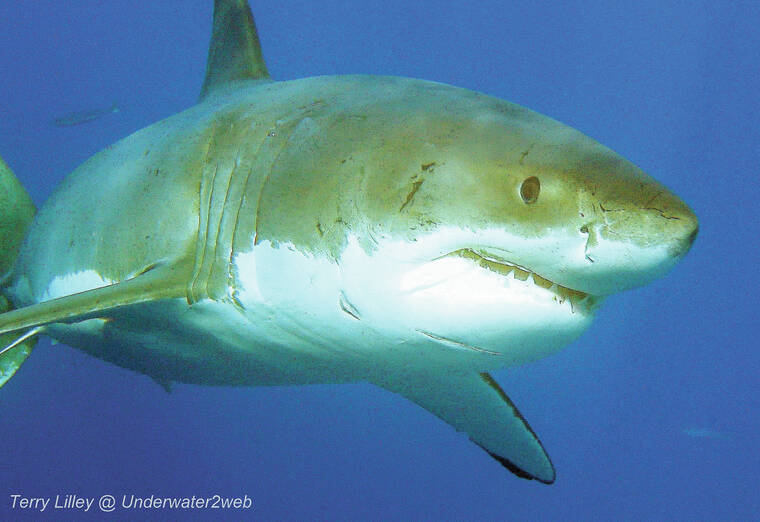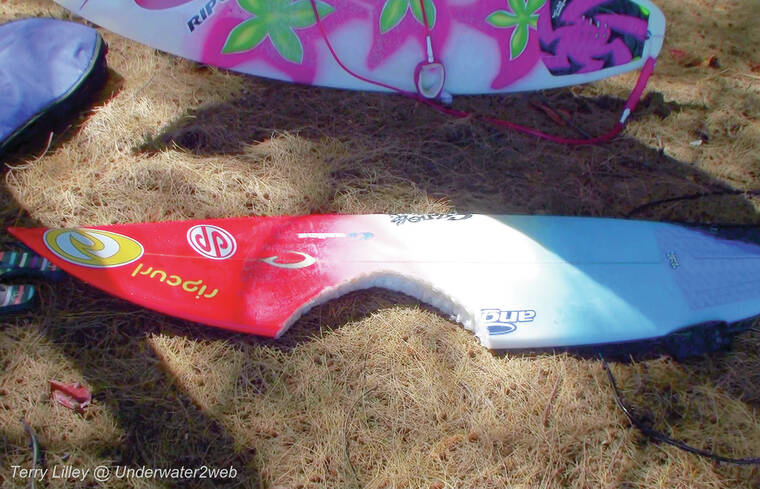For the past five years, I have been in the National Geographic series every summer called “When Sharks Attack.”
The purpose of the show is to expose possible explanations for why sharks sometimes bite swimmers, surfers, paddlers and divers here in Hawai‘i. We know these are not “shark attacks,” but are accidental shark bites. These bites are super rare, but they do happen. So why?
On average 12 people per year on Earth get killed by sharks, but over 200 people a year get killed by dog bites and over 500 people die from bee stings!
In past episodes I showed how leaking cesspools and sewage injection wells in Maui lead to more large shark activity near surfers and on another show I explain how spearfishing and even military activity can alter shark behavior.
The show currently streaming on the Disney Channel called “Sharktober” is one of my favorite episodes because I have been personally affected by the increase in large shark activity here in Kaua‘i in October, being a surfer and diver.
I was even in the water scuba diving the day before Bethany Hamilton got bit at Tunnels Reef on Kaua‘i North Shore and was accompanied by two large tiger sharks. And then I went to California diving, where a friend of mine was killed right next to me by a great white shark, so I have always wanted to understand large shark behavior for my own personal survival.
In the TV show, we go over common held beliefs about large shark behavior and try to show why these beliefs may not be scientifically logical.
Are large sharks affected by human blood or urine in the water? No. Are sharks affected by undersea volcanic activity? Yes, but does it make them aggressive and when does this happen? Is shark behavior altered by microplastics in the sea water? I am sure they are, but to what extent and is this a seasonal event? Probably not. Are big female sharks more aggressive when ready to give birth? Yes, but no big pregnant sharks have been observed along Kaua‘i North Shore in October.
Every October for 15 years, I have dove a Tunnels Reef shooting video of marine life and I have observed certain patterns in sea turtle behavior. Usually in August there are only a few, if any surfers, at Tunnels because the surf is flat.
In October, we normally get our first large winter swells and Tunnels may have hundreds of surfers out having fun. More people in the water increases the chance of an accidental shark bite. We know that sharks do not eat people and tiger sharks chase and eat sea turtles and sometimes us surfers get in the way of this feeding process and get bit.
All summer long the limu (seaweed) grows on the reef at Tunnels. The sea turtles eat this seaweed. The first large winter swell rips the seaweed off of the reef and it floats in the waves. The sea turtles know this and they line up by the hundreds to get free floating food.
I have some great video of this huge turtle feeding party. The tiger sharks show up in October to feed on the excess amount of sea turtles that are paying attention to all the free food versus looking out for predators trying to eat them. More waves in October, more surfers in the water, more sea turtles and more tiger sharks means more of a chance of an accident happening. Just simple statistics.
Shark behavior can usually be explained, but due to Hollywood movies people tend to be afraid of sharks and fear the unknown. So in the TV show, we try to dispel some of the myths and bring forward some ideas that may explain large shark behavior. We still do not know nearly as much about sharks as we need to. They have been in the ocean a lot longer than us humans and we still have a lot to learn about their behavior.
Check out “Sharktober” on Disney Plus and also “3,000 Sharks And Counting” movie on my webpage at www.underwater2web and make sure to subscribe to my Youtube underwater educational channels at Underwater2web so you can get all my new updated shark movies first before they show up on TV.
•••
Terry Lilley is a marine biologist living in Hanalei Kaua‘i and co-founder of Reef Guardians Hawai‘i, a nonprofit on a mission to provide education and resources to protect the coral reef. To donate to Reef Guardians Hawaii go to www.reefguardianshawaii.org.





Thank you for writing this! I always enjoy reading your articles and I feel like I learn something new every time